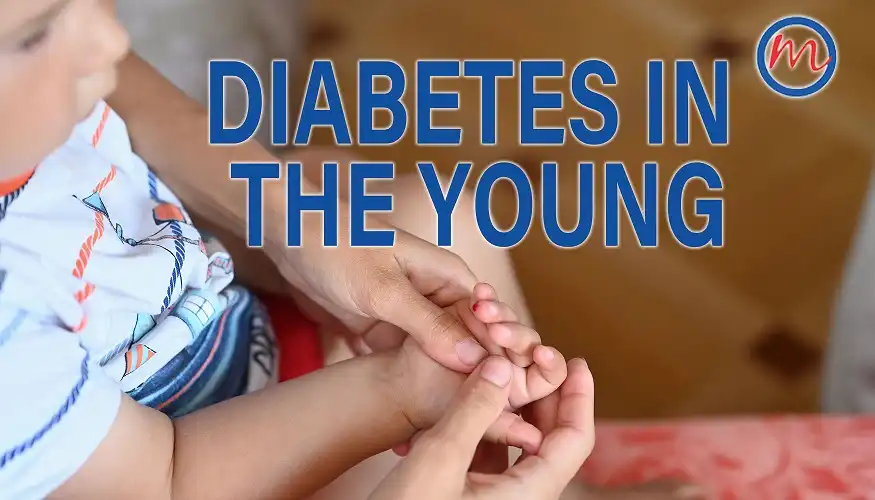Diabetes mellitus is defined as a metabolic disorder of multiple causes characterized by chronic hyperglycaemia with disturbances of carbohydrate, fat and protein metabolism resulting from defects in insulin secretion, insulin action or both leading to changes in both small blood vessels and large blood vessels.
All children with diabetes need not be type 1 diabetes (T1DM)!
Until recently, type 1 diabetes (T1DM) was not only the most common form of diabetes seen in youth, but also perhaps the only form of diabetes seen in children and adolescents. However, this trend has started changing slowly. Type 2 diabetes (T2DM), earlier considered a disorder of middle age or elderly is increasingly being reported among young adults and now also in adolescence and childhood, probably due to the burgeoning epidemic of childhood obesity.
In India, apart from T1DM and T2DM, there are other forms of diabetes in the young including Maturity-onset diabetes of the young (MODY), Fibro calculous Pancreatic Diabetes (FCPD)and the rare genetic forms of diabetes.
A brief description of different types of diabetes in the young in India is given in detail below:
Type 1 Diabetes (T1DM)
T1DM is an autoimmune disease with progressive destruction of β-cells, leading to polyuria, polydipsia, weight loss and hyperglycaemia. Making a proper diagnosis of T1DM with clear evidence of β-cell destruction through the presence of islet cell autoantibodies and demonstration of absent β-cell function as measured by levels of C peptide and prescribing the appropriate doses of insulin are the basis for precision medicine in the case of T1DM.
- T1DM mostly has a sudden onset in children and adolescents and can be easily identified by classic symptoms.
- T1DM is a condition in which the immune system destroys the insulin-producing beta cells of the pancreas.
- It can strike at any age varying from below one year of age to elderly age usually occurs in children and adolescents.
- T1DM accounts for 5 to 10 percent of all diagnosed cases of diabetes and is the leading cause of diabetes in children and adolescents.
- Since the pancreas in T1DM can no longer produce insulin, those with T1DM are required to take insulin daily for survival, either by injection or via an insulin pump.
Risk Factors:
A combination of genetic and environmental factors put people at increased risk for type 1 diabetes.
- Viral infections
- Race/Ethnicity
- Family history
- An early diet like consuming cow’s milk
- Other autoimmune conditions like Graves’s disease
- Presence of certain genes
Symptoms:
- Excessive thirst and hunger
- Excess urination
- Tiredness
- Sudden weight loss
- Delayed wound healing
- Blurred vision
Children may also feel very tired and weak and sometimes exhibit irritable behaviour.
As insulin deficiency worsens, ketoacids (formed from the breakdown of fat) build up in the blood and are excreted in the urine and breath. They cause the feeling of shortness of breath and abdominal pain, lethargy, muscular cramp, disturbed consciousness, vomiting and worsening dehydration.
High blood sugar, acidosis and dehydration together cause the condition known as diabetic ketoacidosis or DKA. If diabetes is not diagnosed and treated with insulin at this point, the individual can lapse into a life-threatening diabetic coma.
Treatment: Insulin is the only treatment for children with T1DM.
Co-morbidities: Although the mortality in children with diabetes has drastically decreased, both acute complications (like ketoacidosis, hypoglycaemic episodes, infections) and chronic complications (like retinopathy, neuropathy, nephropathy, skin infections and psychological disturbances) lead to increased morbidity and premature mortality in T1DM.
Type 2 Diabetes (T2DM)
T2DM is a heterogeneous group of disorders predominantly due to insulin resistance and some degree of an insulin secretion defect. T2DM has a range of risk factors, aetiologies and clinical presentations.
- T2DM is rare in children younger than 10 years of age, regardless of race or ethnicity. After 10 years of age, type 2 diabetes becomes increasingly common, especially in certain racial and ethnic groups such as African Americans and South Asians.
- The first stage in the development of T2DM is often insulin resistance, requiring increasing amounts of insulin to be produced by the pancreas to control blood glucose levels.
- Initially, the pancreas responds by producing more insulin, but after several years, insulin production may decrease and diabetes develops.
Risk Factors: Overweight and obese children are at increased risk for developing T2DM during childhood, adolescence or later in life as obesity increases the chances of insulin resistance.
- Being overweight (BMI > 23.0 kg/m2),
- A family member especially parent who has type 2 diabetes
- Belong to a high risk racial or ethnic group
- Having signs of insulin resistance
- Being older than 10 years of age and
- Physically inactive and improper meal pattern
Symptoms: Type 2 diabetes usually develops slowly and steadily in children. Symptoms are same as to those of type 1 diabetes. Some children or adolescents with type 2 diabetes may show no symptoms at all when they are diagnosed and others may present with vaginal yeast infection or burning on urination due to yeast infection. Some children may have extreme elevation of the blood glucose level associated with severe dehydration and coma. Therefore, it is important for health care providers to identify and test children or teens who are at high risk for this condition.
Physical signs of insulin resistance include
- Acanthosis nigricans (where the skin around the neck or in the armpits appears dark and thick, and feels velvety).
- High blood pressure
- Dyslipidaemia
- Polycystic ovary syndrome (infrequent or absent periods, and excess hair and acne).
Treatment: Type 2 diabetes is usually managed with oral hypoglycaemic agents and by following regular dietary pattern and physical activity. They mayneed insulin also if their sugars are not under control.
Co-morbidities: Children with type 2 diabetes also are at risk for the long-term complications of diabetes and the co-morbidities associated with insulin resistance (lipid abnormalities, hypertension, albuminuria, polycystic ovarian disease [PCOD], non-alcoholic fatty liver disease [NAFLD]).
Monogenic forms of diabetes
- Maturity-onset diabetes of the young (MODY)
- Maturity-onset diabetes of the young (MODY), is a rare form of diabetes in children that is caused by a single gene defect that results in faulty insulin secretion.
- MODY is thought to account for 2 to 5 percent of all cases of diabetes and often goes unrecognized.
- Different subtypes of MODY from MODY 1 to MODY 14 were identified, each with specific genetic defect in one of the other chromosome.
MODY is defined by its
- Early onset (usually before age 25)
- Absence of ketoacidosis
- Well preserved beta cell function
- Do not require insulin for management as initial treatment; respond well to sulphonylureas.
- Absence of acanthosis nigricans
- Strong family history of diabetes (3 generations -autosomal dominant inheritance)
Thus, each child of a parent with MODY has a 50 percent chance of inheriting the same type of diabetes. With these above clinical features, a number of youth onset individuals were classified as MODY. However, the problem at that time was that in the absence of a specific genetic marker, MODY was often confused with T2DM which occurs in the young. Once the genetic defects in MODY were identified, it was then possible to accurately diagnosed MODY. Of the 14 varieties of the MODY that have been described, some forms like MODY 1,2,3 and 5 are well known and the clinical features are well characterized.
Treatment: Some children respond to diet therapy, exercise, and/or oral anti-diabetes medications that enhance insulin release. Others may require insulin therapy. Depending upon the type of MODY, the treatment varies vastly. Oral hypoglycaemic agents work well for MODY 1, 3 and 4. MODY 1 and 3 require insulin eventually. MODY 2 rarely requires drug or insulin therapy and can usually be managed by exercise and diet alone. MODY 5 may require different treatments because it has other problems in addition to diabetes.
For details visit:https://oldlive.drmohans.com/what-is-maturity-onset-diabetes-of-the-young-mody/
If a young patient is diagnosed with what looks like T1DM but has atypical features, example, the pancreatic beta cell function seems to be relatively preserved (C-peptide levels are present) and if the antibodies associated with T1DM like GAD antibody, Zinc transporter, IA-2, ICA, etc., are absent, it is well worth screening that person for MODY. By doing a simple genetic screening test, it can be identified whether the person has MODY and also which type of MODY.
- Neonatal diabetes (NDM)
NDM is a very rare form of diabetes. It can be mistaken for type 1 diabetes however neonatal diabetes is usually with onset below 6 months of age. Neonatal diabetes is classified under Monogenic forms of diabetes which means it is due to a mutation of gene. Mutations in several genes can be involved in causing neonatal diabetes. There are two main forms of NDM. They are
Transient neonatal diabetes (TNDM)sets in before six months of age but usually disappears within a year of birth but can reappear typically during adolescence. Permanent neonatal diabetes (PNDM), once diagnosed in infancy i.e. sets usually before six months of age but unlike TNDM, it stays for the rest of the life.
Causes: Neonatal DM is caused by a single mutation in an increasing number of identified genes. These genes have important roles in the normal development and function of pancreatic beta cells including insulin production and secretion.
Symptoms: Persistent thirst, frequent urination and dehydration.
Treatment: Neonatal diabetes will usually either be treated with oral drugs or insulin. This treatment may not be required as the child grows up depending on the type of diabetes.
Fibro-calculous Pancreatic Diabetes (FCPD)
This is a unique form of diabetes seen in tropical countries secondary to non-alcoholic chronic calcific pancreatitis.
Patients with FCPD are generally lean, from poor socioeconomic status and usually present with a history of intermittent but severe abdominal pain since childhood, sometimes with steatorrhea (oily stools), pancreatic function tests will be abnormal and signs of insulin resistance will be absent. Abdominal CT scan/ultrasonography will show multiple, large, dense, pancreatic calculi.
Dr. Mohan’s criteria for FCPD
- Patient should originate from a tropical country
- Diabetes should be present
- Demonstrable evidence of chronic pancreatitis: pancreatic calculi on X-ray abdomen or unequivocal ductal dilatation on ultrasonography /CT scan or at least three of the following:
- Recurrent abdominal pain since childhood;
- Steatorrhea;
- Altered pancreatic morphology, e.g., increased echogenicity;
- Abnormal pancreatic function tests.
- Absence of other causes of chronic pancreatitis, i.e., alcoholism, hepatobiliary disease, primary hyperparathyroidism, etc.

Treatment: Oral hypoglycemic agents may be useful in a few patients with mild diabetes and relatively early in the course of the disease. However, the majority of patients eventually need insulin for control of diabetes and to improve their general health and sense of well-being. FCPD is a pre-malignant condition and hence screening for pancreatic adenocarcinoma should be done particularly if there is history of weight loss or jaundice.
Precision Diabetes Treatment at Dr.Mohan’s Diabetes Specialities Centre
Diabetes is a complex health condition where symptoms differ from individual to individual and so does the diagnosis. It is important to diagnose and understand an individual’s body type, genes and other factors before prescribing any sort of treatment. An individual’s diagnosis can only be prescribed after assessing and conducting the essential tests. Thus, the precision method provides tailor-made diagnosis and treatment for people with diabetes. Diagnostic tests and therapies are selected not only on the basis of generic symptoms but also by the specific risk factor profile and health history obtained from genetic profiling.
Precision diabetes will make it possible to accurately classify a patient and determine the type of diabetes any individual is suffering from depending on which the treatment for the patient will be prescribed. At Dr.Mohan’s Diabetes Centre, we do various tests at our centre to determine the type of diabetes. We constantly try to innovate and provide the best diabetes care to our patients. We believe this approach will not only provide accurate and relevant treatment but also have a huge impact on the cost of managing diabetes.
Take-Home Messages
- All young patients need not have T1DM and age alone should not be taken as the criteria for diagnosing T1DM
- Complete evaluation must be done to arrive at a diagnosis (Components given as Table 1)
- A strong family history of diabetes is a good pointer to T2DM
- Look for signs of insulin resistance – Obesity, Acanthosis Nigricans
- C – Peptide assay and GAD antibody could help in distinguishing T1DM and T2DM.
- A good clinical history, detailed pedigree chart and simple tests can help to classify diabetes and this helps us to give the appropriate treatment.
- Genetic testing can help to diagnose monogenic diabetes like MODY and Neonatal Diabetes.
- Suspect that a child may not have T1DM if GAD antibody is negative and some residual insulin reserve is good.
Table 1: COMPONENTS OF THE COMPREHENSIVE DIABETIC EVALUATION:
| MEDICAL HISTORY | PHYSICAL EXAMINATION | LABORATORY TESTS for diagnosis |
| Age with characteristics of onset of diabetes. ( e.g. Diabetic Ketoacidosis – DKA, weight loss, osmotic, infections etc.) | Height | Oral Glucose tolerance test |
| Eating patterns, nutritional status, weight history, growth and development in children and adolescents. | Weight | Fasting plasma glucose |
| Family history of diabetes (to draw pedigree chart) | Body mass index | Postprandial plasma glucose
(1½ hours after food) |
| Review of previous treatment regimen and response to therapy (diabetes, dyslipidaemia, blood pressure, thyroid problems etc.) | Blood pressure | HbA1C |
| Any prior hospitalizations for DKA, hypoglycaemia, surgeries etc. | Clinical Markers like Acanthosis Nigricans | C-Peptide |
| GAD antibody | ||
| Abdominal X-ray (for pancreatic stones) | ||
| Urine complete examination |
Dr.A.AMUTHA & DR.V. MOHAN
Dr. Mohan’s Diabetes Specialities Centre & Madras Diabetes Research Foundation, Chennai, India
References:
- Amutha A, Datta M, Unnikrishnan R, Anjana RM, Mohan V. Clinical profile and complications of childhood- and adolescent-onset type 2 diabetes seen at a diabetes center in south India. Diabetes Technol Ther. 2012 Jun;14(6):497-504. doi: 10.1089/dia.2011.0283. Epub 2012 May 2. PMID: 22551567.
- Amutha A, Datta M, Unnikrishnan IR, Anjana RM, Rema M, Narayan KM, Mohan V. Clinical profile of diabetes in the young seen between 1992 and 2009 at a specialist diabetes centre in south India. Prim Care Diabetes. 2011 Dec;5(4):223-9. doi: 10.1016/j.pcd.2011.04.003. Epub 2011 May 23. PMID: 21601548.
- Amutha A, Unnikrishnan R, Anjana RM, Mohan V. Prepubertal Childhood Onset Type 2 Diabetes Mellitus: Four Case Reports. J Assoc Physicians India. 2017 Feb;65(2):43-46. PMID: 28457031.
- Jahnavi S, Poovazhagi V, Mohan V, Bodhini D, Raghupathy P, Amutha A, Suresh Kumar P, Adhikari P, Shriraam M, Kaur T, Das AK, Molnes J, Njolstad PR, Unnikrishnan R, Radha V. Clinical and molecular characterization of neonatal diabetes and monogenic syndromic diabetes in Asian Indian children. Clin Genet. 2013 May;83(5):439-45. doi: 10.1111/j.1399-0004.2012.01939.x. Epub 2012 Aug 20. PMID: 22831748.
- Anuradha S, Radha V, Deepa R, Hansen T, Carstensen B, Pedersen O, Mohan V. A prevalent amino acid polymorphism at codon 98 (Ala98Val) of the hepatocyte nuclear factor-1alpha is associated with maturity-onset diabetes of the young and younger age at onset of type 2 diabetes in Asian Indians. Diabetes Care. 2005 Oct;28(10):2430-5. doi: 10.2337/diacare.28.10.2430. PMID: 16186275.
- Radha V, Ek J, Anuradha S, Hansen T, Pedersen O, Mohan V. Identification of novel variants in the hepatocyte nuclear factor-1alpha gene in South Indian patients with maturity onset diabetes of young. J Clin Endocrinol Metab. 2009 Jun;94(6):1959-65. doi: 10.1210/jc.2008-2371. Epub 2009 Mar 31. PMID: 19336507.
- Mohan V, Mohan R, Susheela L et al. Tropical Pancreatic Diabetes in south India: heterogeneity in clinical and biochemical profile . Diabetologia 1985;28: 229-232.
- Mohan, V(1993) Fibrocalculous Pancreatic Diabetes (FCPD) in India. International Journal of Diabetes in Developing Countries, 13 . pp. 14-21.



